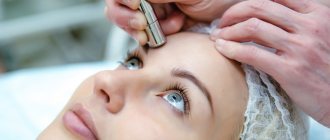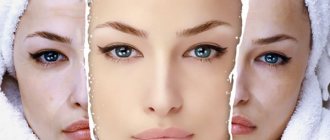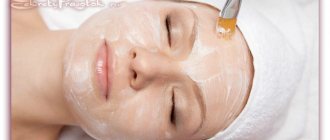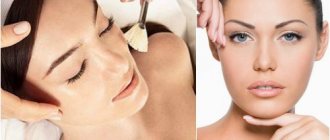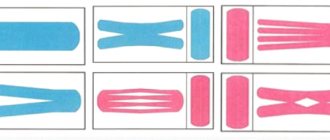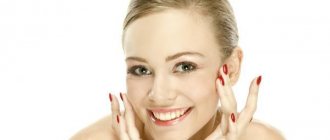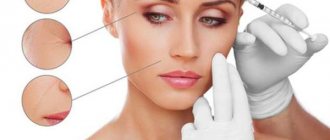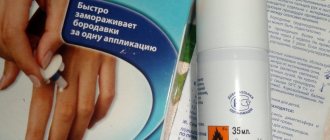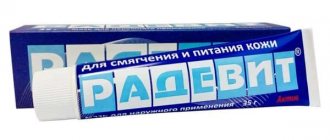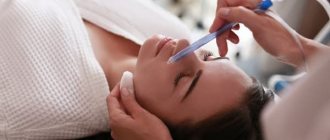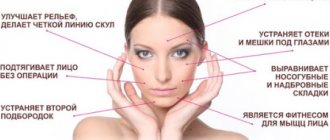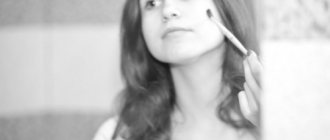Indications for use
The rapid constriction of blood vessels when exposed to low temperatures and their subsequent expansion creates a therapeutic cosmetological effect.
The indications for facial cryomassage with liquid nitrogen are quite wide, including:
- improvement of skin tone and blood circulation;
- to consolidate the results obtained during Botox;
- skin lightening;
- elimination of flabbiness;
- reducing the appearance of wrinkles;
- treatment of seborrhea, reduction of allergic rashes;
- elimination of warts;
- elimination of papillomas;
- acne treatment;
- getting rid of acne.
In some cases, cryomassage acts as a complex effect during procedures such as ultrasound or mechanical skin cleansing.
Why is liquid nitrogen used for the face in cosmetology?
Liquid nitrogen has a powerful anti-inflammatory effect and procedures using it are often prescribed after chemical peeling or other types of skin cleansing in order to prevent complications. In addition, liquid nitrogen has a resolving effect and solves related problems.
Since the product is applied to the face along massage lines using a special device, the procedure fully lives up to its name. And this is the third positive quality of cryomassage. Together, all this improves the condition of the skin and significantly changes its appearance.
The results of a full course of cryotherapy always delight patients, since after it, facial wrinkles are completely smoothed out, and deep ones become almost invisible. The skin texture is evened out. If there were papillomas or warts before, then by the last session they completely disappear. The problem of comedones and acne is solved. The function of the sebaceous glands is normalized, and this, in turn, removes oily shine from the face. Pigment spots are completely lightened.
In the photo you can see the difference between facial skin before and after the procedure.
Contraindications to the procedure
Contraindications for cryomassage of the face with liquid nitrogen are not a very large list:
- rosacea;
- acne with pustules;
- post-infarction condition;
- post-stroke condition;
- cardiac diseases;
- high blood pressure;
- tendency to migraines;
- exacerbation of herpes;
- increased body temperature;
- individual intolerance to low temperatures.
Caution should be exercised when performing cryomassage of the face during pregnancy. Hormonal changes can affect the condition of facial skin. During manipulations, you should pay attention to your well-being.
Cryomassage at home
Due to the fact that liquid nitrogen is stored in special equipment (as opposed to conventional freezing), the possibility of carrying out such a manipulation at home is unlikely.
A good and affordable method of using cold on the face at home is to wipe the skin with a piece of ice.
Cryomassage with ice will be even more useful if you saturate the freezing water with all kinds of medicinal decoctions (for example, chamomile, celandine).
In fact, you can add a lot of things to ice - pieces of fruits and vegetables, herbs. Citrus fruits, strawberries, and tomatoes are good for problematic, shiny and oily skin. For dry skin, in turn, you can include mint and plantain in frozen cubes.
Before using the finished ice, you need to let it melt slightly and only then can you carefully massage your face along the massage lines.
The duration of the home procedure is from 3 to 5 minutes.
Another option is to prepare a creamy mass (puree) of vegetables or fruits, then add a little olive oil to it and put it in the freezer. This method improves the absorption of nutrients into the skin, contributing to its deeper saturation.
Beauty salons also offer cryomassage with bags filled with ice or just ice cubes. Just why go to them if you can easily do an ice massage yourself.
Cryomassage technology
Preparation for the procedure
No complex preparation is required before performing cryomassage:
- a consultation is carried out with a specialist on the choice of exposure technique and duration of the procedure;
- It is not recommended to do peeling the day before visiting a beauty salon;
- Before the procedure itself, the facial skin is cleansed of decorative cosmetics, the hair is removed from the face under a bandage.
Performing cryomassage
Liquid nitrogen is located in a beauty salon in special devices - thermoses. To perform a massage, you need an applicator - a wooden stick with a cotton swab.
Performing this type of massage includes the following stages:
- The salon client is placed on a couch.
- The whole body is covered except the head.
- The cosmetologist dips the applicator in liquid nitrogen and runs it along the massage lines with quick movements.
- Immediately after the session, apply a nourishing cream.
- You can go outside in half an hour.
During the cryomassage procedure, the applicator does not touch the surface of the skin. The skin is exposed directly to evaporating liquid nitrogen. But when indicated, a short-term effect on a certain area through direct contact is possible.
Skin restoration
Recovery time is no more than a couple of hours, when the skin can retain a reddish tint.
If peeling occurs as a result of acne treatment, it is necessary to periodically apply moisturizing and nourishing creams, as well as anti-aging creams. Important: After cryomassage procedures, sunbathing is not recommended for 2 months.
Modes of exposure
The cosmetologist, depending on the indications, selects modes of treatment of the facial skin:
- For rosacea, cryomassage is performed along massage lines on the area with redness, without contact with the surface of the skin. Duration – up to 5 minutes, work for each zone – 10 seconds.
- Direct point contact with the skin is recommended for purulent rashes. Each place must be processed up to 3 times.
- For blackheads, during exposure (15 seconds for each zone), pores narrow, and the amount of pathogenic microflora decreases.
- For peeling, exposure time is approximately half a minute. This time allows you to start the process of tissue regeneration.
- To increase the tone of tired skin, or with signs of aging, a short-term effect is performed, leading to vasoconstriction when exposed to low temperatures. Afterwards, the vessels dilate and renewal processes begin.
In addition to the already well-known wooden stick with a swab at the end, other special equipment can be used.
Important: The session time is approximately a quarter of an hour. To achieve a lasting effect, it is advisable to undergo at least 10 procedures with breaks of 2 to 3 days.
Skin care after the procedure
After cryomassage, redness of the skin may be observed. This is normal; hyperemia occurs as a result of stimulation of blood circulation. The redness goes away on its own within a few hours. Peeling may occur, which is also considered normal. Immediately after the procedure, you can use regular moisturizing creams that quickly cope with dryness.
It is recommended to avoid open sun for the first week. The skin at this time is susceptible to ultraviolet radiation, so the procedure is done in winter or autumn, during the period of decreased solar activity. Before going outside, cover your face with protective cream with an SPF of at least 20. You cannot use foundation.
Alcohol-free lotions are used for washing after cryomassage. Soap can cause skin irritation. Makeup should only be applied with clean hands. The doctor will tell you more about care after the first procedure of treating the skin with liquid nitrogen.
Advantages and disadvantages of the procedure
The wide popularity of manipulations aimed at maintaining beauty and rejuvenation through exposure to low temperatures has a number of undeniable advantages.
Among the obvious advantages are:
- quick noticeable results that appear after the first session;
- getting rid of skin defects such as warts and pimples;
- painlessness;
- the price of facial cryomassage with liquid nitrogen is relatively low;
- the procedure can be combined with others aimed at maintaining youth and beauty;
- suitable for those who are prohibited from mesotherapy;
- lack of pigmentation of the dermis, since the time of exposure to cold is short;
- quick recovery after a session;
- improved blood circulation;
- increasing the elasticity of the dermis;
- increasing oxygen supply to the skin of the face;
- the ability to repeat cryomassage up to several times a week.
The disadvantages include:
- To achieve the effect, it is desirable to carry out several procedures;
- the price of a whole set of procedures may be high, despite the fact that a separate procedure is inexpensive;
- It is not recommended to carry out manipulations in the summer, when the sun has an aggressive effect on the skin;
- the presence of some contraindications;
- During the procedure there may be an unpleasant tingling sensation;
- It is possible that swelling, redness and peeling of the skin may occur after the procedure.
Note : Cryomassage can be used for both women and men.
Indications and contraindications
Indications
- cellulite;
- overweight and obesity;
- skin diseases;
- prevention of skin aging;
- improvement of turgor, elasticity and skin color;
- diseases of the ENT organs and respiratory system;
- menopause, infertility;
- recovery after injuries and operations;
- diseases of the nervous system;
- diseases of the musculoskeletal system;
- preparation and rehabilitation after cosmetic procedures.
Contraindications
A number of different diseases are contraindications to the use of cryotherapy. In any case, before starting cryoprocedures, you must undergo an examination and consult a therapist.
Cryotherapy is not recommended for the following diseases:
- blood diseases;
- various chronic diseases in the acute stage;
- severe cardiovascular diseases;
- mental disorders;
- acute infectious and respiratory diseases;
- allergy to cold;
- renal failure;
- presence of open wounds;
- thromboembolism;
- pregnancy and breastfeeding;
- malignant tumors;
- active pulmonary tuberculosis;
- hemorrhagic diathesis;
- claustrophobia.
Types of cryomassage
Based on the degree of impact, low-temperature nitrogen massage is divided into two types:
- Standard. Consists of a liquid nitrogen treatment in which the applicator with the swab does not touch the skin.
- Deep. This is severe freezing with destruction of the tissue surface. This type of exposure is necessary to remove papillomas and other formations on the skin. The local effect does not affect neighboring tissues.
Cryomassage of various zones
In addition to the face, cryomassage is also used on other parts of the body. Among the areas of application:
- reducing the appearance of cellulite on the buttocks and thighs;
- cryomassage of the scalp;
- weight normalization;
- removal of scars that remain after surgical interventions;
- removal of warts and papillomas on the body;
- for general rejuvenation - cryomassage of the body;
- improvement of skin condition on the décolleté area.
Indications for nitrogen head massage
- If your hair is falling out
- There is itching
- Headache or migraine
- Fat metabolism is disrupted
- You are not satisfied with the appearance of your hair (provided that this is due to a violation of its nutrition)
Thus, cryomassage, although not a panacea for all hair and scalp problems, can really help with many of them, eliminating both the causes and the effect.
How many cryotherapy treatments do you need to undergo?
Usually a course of 10-15 procedures is prescribed. If necessary and if indicated, the course can be repeated two or three times.
Is it possible to do cryotherapy in spring and summer?
Can. There are no seasonal restrictions on cryotherapy. In hot weather, the procedure is especially comfortable and easily tolerated, since the skin retains a feeling of cold and then coolness for some time.
Will there be peeling after the procedure?
Peeling can be caused by cryopilling. It is performed only on the facial skin. Peeling on the scalp is usually not observed.
If a person has weak blood vessels, can he undergo cryotherapy?
Can. Alternating cold and heat strengthens weak blood vessels and helps normalize the body's thermoregulation processes.
What is cryotherapy for the scalp combined with?
Cryomassage of the head with liquid nitrogen goes well with therapeutic hair masks, strengthening lotions, and darsonvalization of the scalp.
It should be remembered that the low temperature of liquid nitrogen causes dryness and brittle hair, therefore, during the use of cryotherapy, you should carefully monitor the state of sebum secretion.
To sign up for cryotherapy with liquid nitrogen or get a consultation, select a suitable salon and call the phone number indicated there.
Prices for procedures
| Cryomassage | ||
| Face | 600 rub. | |
| Face, neck, décolleté | 1000 rub. | |
| Head | 800 rub. | |
| Hands/feet | 500 rub. | |
| Spine | 1000 rub. | |
| Cervical-collar area | 800 rub. | |
| Buttocks, thighs, legs and feet | 2000 rub. | |
| Belly | 1000 rub. | |
| joint | 500 rub. | |
How many cryomassage procedures are needed to obtain a sustainable effect?
The number and frequency of cryomassage sessions is determined by a cosmetologist, based on the patient’s age, the condition of the skin, the presence of diseases and the place of treatment with liquid nitrogen.
A standard course of facial cryomassage includes 10 to 14 procedures every two to three days. Depending on the condition of the skin, one procedure takes from 5 to 20 minutes.
For hair loss and seborrhea, it is recommended to undergo 10 to 15 cryomassage procedures with a frequency of two to three sessions every week.
For professional cryomassage of the face in Moscow, contact the Center for Medicine and Cosmetology “Health”. We offer a painless, effective procedure - cryomassage at an affordable price, which will get rid of various cosmetic problems, improve the general condition and appearance of the skin, improve immunity and the general condition of the body.
The reception is conducted by Lyudmila Gusanovna Ismailova
Graduated from the Russian State Medical University with a degree in general medicine; completed clinical residency at the First Moscow State Medical University at the Department of Dermatovenereology; completed advanced training courses in therapeutic and hardware cosmetology at the RUDN University.
